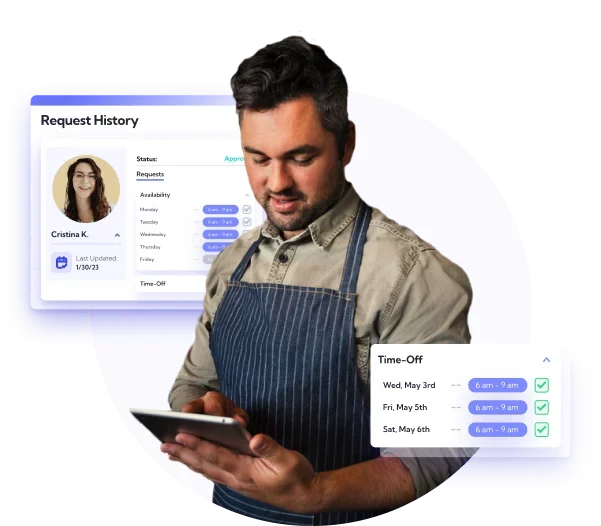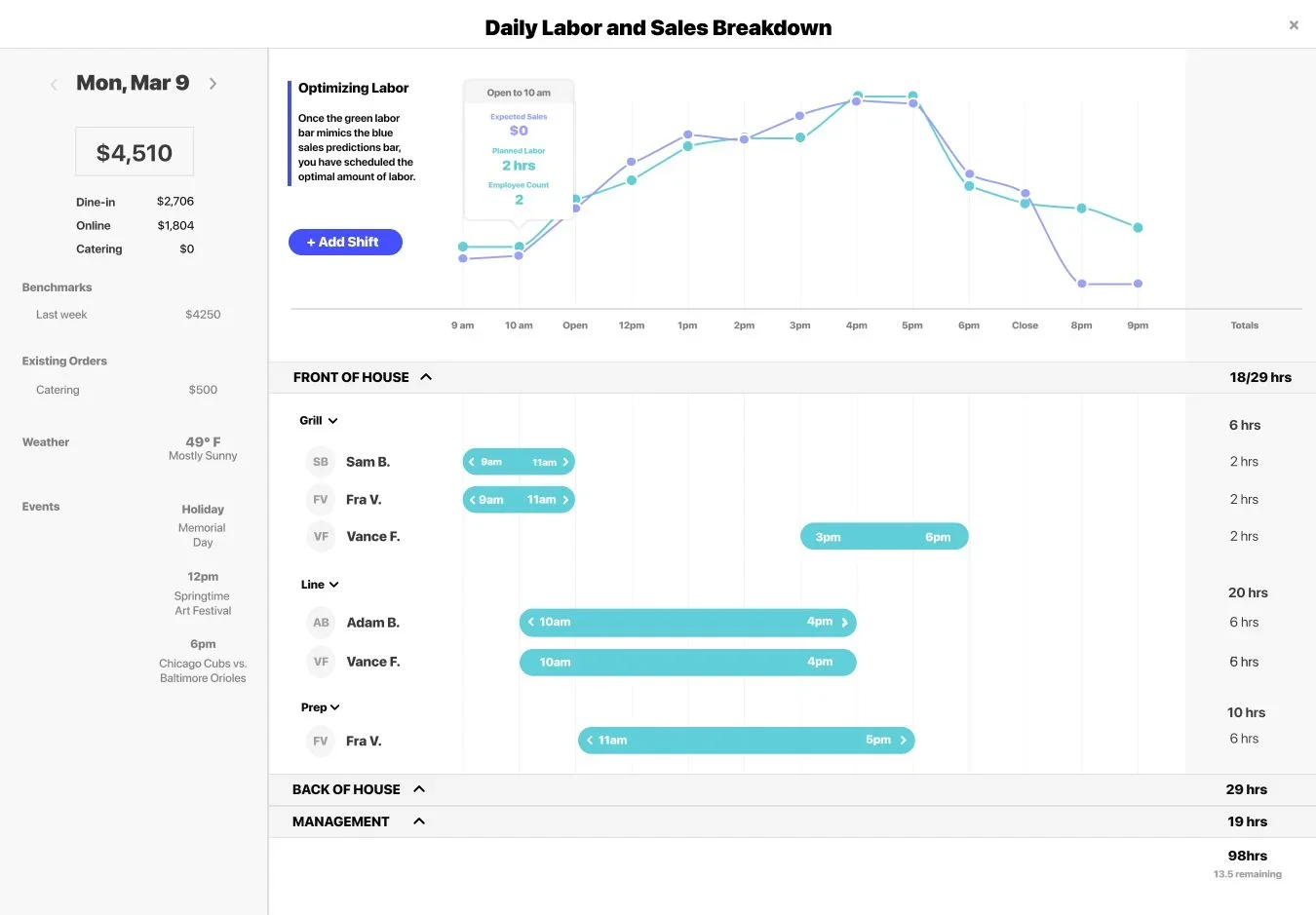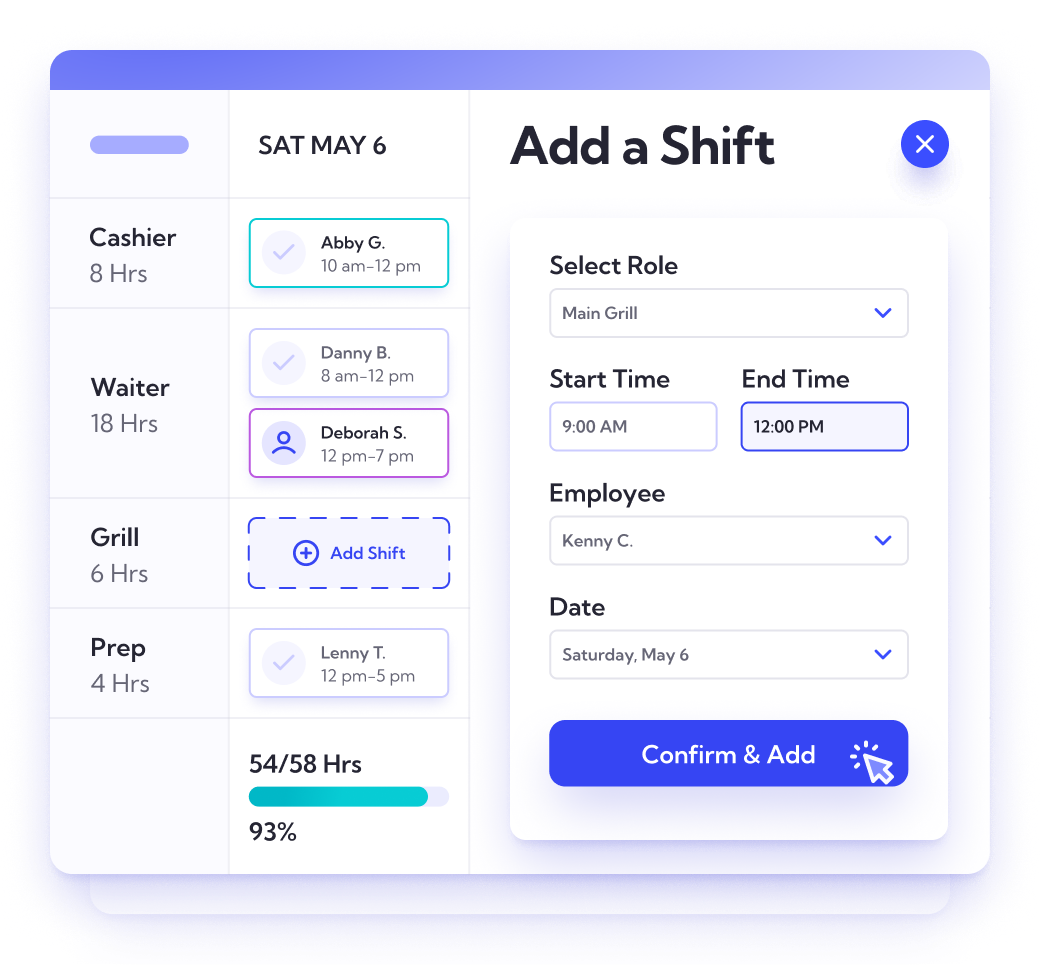Building a restaurant schedule might seem simple enough on the surface, but anyone who’s done it for long enough knows it can sometimes feel like putting together a puzzle with pieces missing. Between employee availability, time off requests, worker shortages, inconsistent peak hours, and more, you might start wondering if you need a PhD in the science of scheduling.
As difficult as it sometimes is, efficient employee scheduling is the backbone of success. A well-thought-out and optimized staff schedule ensures that you have the right number of employees with the necessary skills at the right time, allowing your restaurant to provide excellent service and maximize productivity. But you also need to factor in profitability and employee satisfaction. Adding too many workers to the schedule when order volume is low results in lower profit margins for your business and lower earnings per worker.
Optimized staff scheduling offers numerous benefits to your restaurant.
First and foremost, it enhances restaurant employee satisfaction and morale. When employees have predictable schedules and enough time off, they experience less stress and are more motivated to deliver their best performance. In today’s world of high turnover and staffing shortages, employee retention is extremely important.
Optimized scheduling also allows for better labor cost control, as well as allowing things to run more smoothly. If you can achieve the right number of staff at all times, you can streamline operations and improve the overall efficiency of your restaurant. Make that your goal.
In this blog post, we will explore the best tips for creating an efficient restaurant work schedule that fosters a happy and productive work environment for staff, while maximizing service quality and increasing the bottom line.
1. Understand the Needs of Your Restaurant and Staff
To create an effective schedule, you must first take your restaurant's unique staff needs into consideration.
Start by analyzing your peak hours and demand patterns. Identify the busiest days and times, and schedule more staff during these periods to ensure a seamless dining experience for your guests. During slower hours, you can reduce the number of employees, optimizing labor costs while maintaining high-quality service. It helps to have a consistent restaurant forecasting practice that factors in historical sales, upcoming events, and more.
This restaurant sales forecasting template can help with that.
When creating the schedule, take into account employee availability and preferences.
Understanding when your staff prefers to work can lead to higher job satisfaction and a more cooperative workforce. Consider implementing shift bidding, where employees can request preferred shifts or time off in advance, ensuring their personal needs are met while also satisfying the restaurant's staffing requirements. Pay attention to which employees work well together and which don’t. Make sure you have some of your top performers scheduled during the toughest shifts. It’s important to keep communication open in your restaurant to ensure everyone is satisfied with their hours.
2. Utilize Restaurant Scheduling Software
Modern technology offers valuable solutions for restaurant scheduling. A good scheduling tool can streamline the entire process, saving time for restaurant management and reducing scheduling errors. Look for scheduling apps and tools that offer automation and integration with other systems, such as your POS (Point of Sale) software. This integration ensures that all data is up to date and accurate, preventing discrepancies between scheduled and actual working hours.
Scheduling apps also enables you to create templates for recurring schedules, making it easier to plan weekly or monthly shifts. You can set up predefined roles and positions, saving you time and effort in creating schedules.
Furthermore, scheduling software often comes with features like shift swapping, messaging, and cover requests, allowing employees to manage their schedules better. By giving staff some control over their work hours, you foster a sense of ownership and engagement, leading to higher morale and lower turnover rates.
Lineup.ai’s scheduling software for restaurants allows for all of this, while also providing AI-assisted labor forecasting to help you build schedules based on real-world, future-looking, and historical data.

3. Implement a Flexible Scheduling Approach
Flexibility is crucial in the restaurant industry, where last-minute changes to a work schedule are common. Encourage open communication with your staff and implement a system for shift swapping and cover requests. This approach empowers employees to manage their schedules, making it easier to accommodate unexpected situations such as emergencies or sudden changes in availability.
To promote flexibility, cross-train your employees in various roles and make sure they’re prepared to step in any day of the week if need be. When employees are trained in multiple positions, they can fill in for absent team members or support during peak periods. Cross-training also fosters a more versatile and engaged workforce, allowing employees to gain valuable skills and advance their careers within the restaurant. Let employees know if you might want them on-call for a given shift so as not to surprise them.
Another valuable practice is building buffer time into your schedule. Unforeseen delays, last-minute schedule changes, or busy periods might require additional staff, and having a buffer ensures that your restaurant can handle these situations smoothly without compromising the quality of service.
4. Schedule in Advance
Predictive scheduling is a practice that involves scheduling shifts well in advance, typically weeks or even months ahead. This approach benefits both the restaurant and the employees. By providing a clear schedule well ahead of time, employees can plan their personal lives, leading to higher job satisfaction and lower turnover rates. For the restaurant, predictive scheduling allows better workforce planning, better coverage on the busiest shifts, and reduces last-minute scheduling changes, contributing to a more efficient operation.
Consider using this free restaurant scheduling template to get ahead of your scheduling process.
5. Balancing Workload and Employee Well-being
Scheduling issues are among the top 5 reasons restaurant employees quit their jobs.
Finding the right balance between workload and employee well-being is essential for a healthy work environment. Even if they’re hitting a full-time schedule on purpose, overworked employees are more likely to experience burnout and decreased productivity, or quit.
Try to ensure that your employees have at least two consecutive days off to rest and recharge, promoting their well-being and job satisfaction. Make sure you check in from time to time to see how people feel about their workload.
Consider implementing a fair shift rotation system to distribute peak and off-peak shifts evenly among your staff. This practice not only prevents burnout but also gives employees an equal opportunity to work during lucrative shifts. A rotation system also allows employees to experience various roles and tasks, keeping their work exciting and engaging.
Be attentive to signs of burnout among your employees throughout the workweek and check in to see what your employees need. Exhausted staff members are less productive and more likely to make mistakes, which can negatively impact your restaurant's reputation. Regularly check in with your whole team both individually and as a group, and provide support when needed. Encourage a healthy work-life balance, and consider offering flexible schedules or paid time off for employees to recharge and maintain their well-being.

6. Adapt to Seasonal Changes and Special Events
The restaurant industry experiences seasonal fluctuations, which can significantly affect your staffing needs. During peak seasons, such as holidays or summer vacations, you may need to increase the number of employees or extend operating hours to meet higher demand. Conversely, off-peak periods may require a leaner schedule to optimize costs and avoid overstaffing.
Plan ahead for holidays and special occasions, as they often bring a surge in customers. Allocate staff accordingly, considering their availability and the anticipated demand. Proper planning prevents understaffing during busy events and avoids overstaffing during slower times, ensuring your restaurant can efficiently accommodate guests while maximizing staff utilization.
Lineup.ai factors in big events like holidays and uses historical sales data to forecast sales differences by season in your restaurant.

7. Cross-Train Employees
Cross-training your restaurant staff is an excellent strategy to enhance scheduling flexibility. When employees are trained in multiple roles, they can fill in for absent team members or support during peak periods, reducing the need to hire temporary or part-time staff.
Develop a cross-training program that covers essential positions in your restaurant. Encourage employees to learn new skills, and offer incentives for mastering multiple roles. This not only improves your scheduling flexibility but also provides growth opportunities for your staff. Employees appreciate the chance to expand their knowledge and responsibilities, which fosters a sense of loyalty and dedication to the restaurant.
8. Monitor and Analyze Scheduling Data
Collecting and analyzing scheduling data can offer valuable insights into your restaurant's efficiency and employee satisfaction. Regularly seek feedback from your staff about the scheduling process and make adjustments based on their suggestions. Implementing an anonymous feedback system can encourage employees to share their honest opinions without fear of repercussions.
Review scheduling efficiency metrics to identify areas for improvement. Consider using employee shift scheduling software to help optimize, then look for patterns of overstaffing or understaffing, and adjust the schedule accordingly. For instance, if you consistently have idle employees during certain hours, consider reducing the number of staff during those times to optimize labor costs.
Data-driven decisions lead to more effective schedules and better employee morale. By using historical data and feedback, you can fine-tune your scheduling practices, ensuring that your restaurant operates at its peak efficiency while maintaining a happy and motivated workforce.

9. Ensure Compliance with Labor Laws and Regulations
Adhering to employment laws and regulations is critical to avoid legal issues and maintain a positive work environment. Familiarize yourself with restaurant labor laws that apply to your area, including rules about overtime pay, break periods, and maximum working hours per week. Restaurant employee scheduling often has unique laws that other businesses don’t have, so pay close attention.
Ensure fairness and equity in your scheduling practices. Avoid favoritism and create a transparent system for assigning shifts. Treating your employees fairly fosters trust and loyalty within your team and minimizes conflicts among staff members.
Mitigate risks of non-compliance by staying informed about changes in labor laws and promptly updating your scheduling practices accordingly. Consulting legal experts when needed can also help you stay compliant with the latest regulations.
The Bottom Line About Better Scheduling
Optimizing restaurant scheduling is a multifaceted task that requires careful planning and consideration. By understanding your staff's needs, utilizing scheduling software, fostering flexibility, and promoting employee well-being, you can create a positive work environment that benefits both your restaurant and your staff.
Embrace the power of technology, continuously improve your scheduling practices, and ensure compliance with labor laws to build a happy and efficient team that delivers exceptional service to your guests. Remember, a well-organized and content workforce is the heart of a successful restaurant. By prioritizing your staff's well-being and optimizing scheduling practices, you can create a harmonious and thriving work environment that fosters long-term success for your restaurant.
Lineup.ai has everything you need to build the perfect restaurant schedule. It uses AI and machine learning-based forecasts to help you continually put together schedules that win for your business and your employees. Schedule a demo today.
FAQs
Which scheduling practice should an effective restaurant manager avoid?
An effective restaurant manager should avoid inadequate staffing levels, which can lead to overworked employees and decreased service quality. Properly scheduling an appropriate number of staff is essential for employee satisfaction and exceptional customer service.
What makes a good scheduling system?
A good scheduling system is user-friendly, accessible, flexible, and integrated with other tools. It automates tasks, supports communication, ensures compliance, and provides reporting. It empowers employees, is mobile-friendly, and sends notifications. Additionally, it helps manage budgets and can scale with business needs.

The team at Lineup.ai is composed of seasoned professionals who hold deep insights into the unique challenges and pain points of the restaurant industry, and are equally skilled in artificial intelligence, machine learning, and data analytics. This fusion of expertise enables Lineup.ai to create cutting-edge AI solutions specifically tailored for the restaurant sector. The technical and analytical prowess of the team, combined with a deep understanding of the unique challenges faced by restaurants, forms the cornerstone of the company's innovation. The team at Lineup.ai also excels in communicating the benefits and applications of AI and machine learning to businesses, ensuring clients fully leverage the capabilities of these solutions.
More about the author